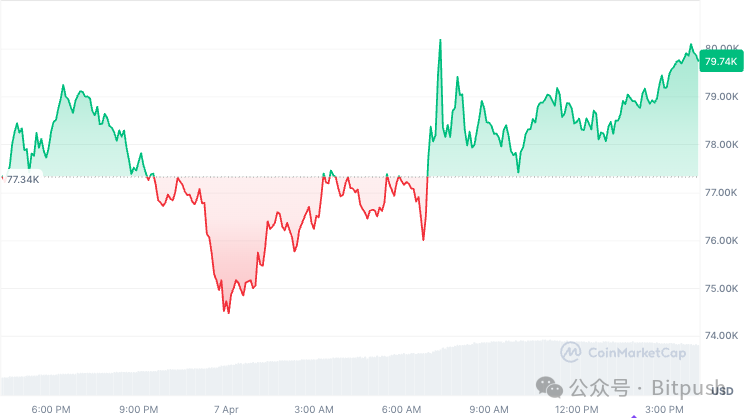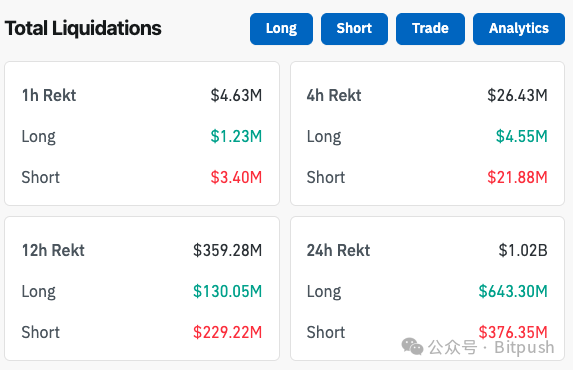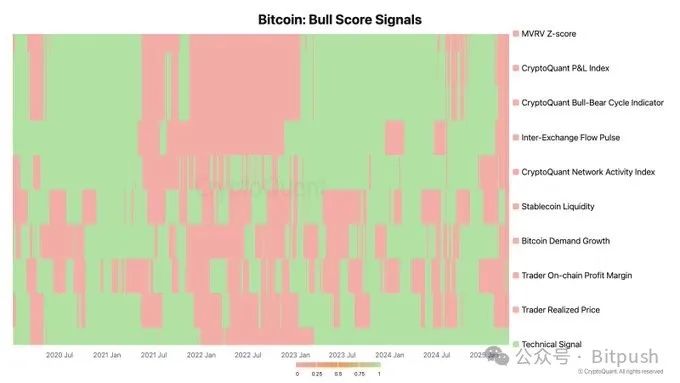Over the past 24 hours, the market trend has fluctuated dramatically with the news. As the details of Trump's tariff policy have repeatedly fluctuated - from rumors of a "90-day suspension" to "refutation of false news", Bitcoin has fluctuated violently within 24 hours, hitting a low of $74,436 and then rapidly rising to $81,200, with an intraday amplitude of up to 9%.
As of writing, Bitcoin is holding onto the key support level of $79,000, while Ethereum is struggling to recover after falling below $1,500, with XRP trading at $1.92.

The derivatives market is full of risk aversion, with the total open interest falling 10% to US$91.19 billion. Coinglass data showed that the amount of liquidations in the past 24 hours exceeded US$1 billion, and the market value of Bitcoin rose slightly to 62.6%.

Expert opinion: What to do next?
Julio Moreno, head of research at CryptoQuant, said:
“Buying the dip is like catching a falling knife! The situation of Bitcoin has not improved yet. There is only one bull signal in the bull score index.”

Pantera Capital general partner Cosmo Jiang told Bloomberg:
"The current market trend is mainly driven by macro factors. The pullback caused by tariffs is a specific event-driven decline, not due to deep economic problems. Just as tariff policy is an artificial variable, when the Trump administration believes that it has obtained enough concessions from other countries, it can also withdraw these measures."
Binance Research’s latest report believes that ongoing geopolitical and economic uncertainty is likely to continue to dominate the market:
“The most aggressive tariffs since the 1930s are creating ripple effects in the macroeconomy and crypto markets. In the near term, cryptocurrencies are likely to remain volatile, with sentiment swinging as the trade war continues to unfold. If macro conditions stabilize, a new narrative takes hold, or crypto reasserts its role as a long-term hedge, renewed growth could ensue. Until then, markets are likely to remain range-bound and react to macro news.”
Stephen Wundke, director of strategy and revenue at quantitative digital asset investment firm Algoz, said:
“For now, markets hate uncertainty, so we can expect more volatile trading in the coming weeks/months, and a delay to the next rally (just [quote] anyway) — unless Trump makes another strong statement about crypto. But the only thing we can be sure of is that there is no certainty in what is being released from the White House at the moment.”
Charlie Sherry, financial director and cryptocurrency analyst at BTC Markets, said in his market update:
“Bitcoin recently lost the key support level of $79,000 to $80,000 that it had successfully held for the past month. This support level marked the bottom of the range after the correction from the all-time high. The next key support level is around $72,000, which was the highest point before the US election. A potential shift in Trump’s stance or emergency intervention by the Federal Reserve are two factors that could help Bitcoin prices rise back above $80,000.”
Bitcoin researcher Axel Adler Jr. noted:
Short-term forecasts show that the price of Bitcoin will fluctuate and consolidate in the range of $81,600 to $88,700, among which the key "biggest pain point" level of $86,000 will become an important benchmark for the expiration of options on April 11. In the medium term, if macroeconomic uncertainty continues and expectations of a Fed rate cut increase, some traditional market funds may turn to Bitcoin for support. However, we need to be wary of the risk of a sharp correction caused by investors' overall risk aversion.
Greg di Prisco, co-founder of centralized stablecoin development company M^0 Labs, commented on the Trump administration’s long-term impact on cryptocurrencies, saying:
Perhaps more important than Trump’s direct actions, his influence on the legislative process is the most important development for the industry. Stablecoin bills considered by state governments will put the United States in a strong position to compete.
Prisco shared his top three predictions for the crypto industry in 2025:
1. I think you will see the GENIUS Act become the bill that the government finally agrees on and eventually passes, but this may happen in the second half of the year. 2. More traditional financial institutions will begin to launch tokenized products inspired by the success of BlackRock BUIDL. 3. Stablecoins will continue to prove themselves as the killer use case for cryptocurrencies. They will begin to integrate into mainstream fintech applications.













